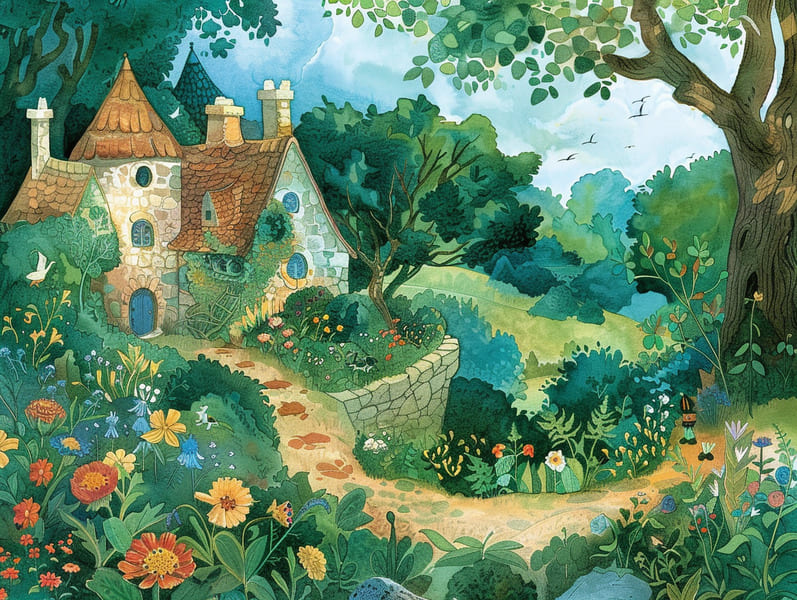The Origins of Ancient Fairy Tales and Its Undying Magic.
The Origins of Ancient Fairy Tales and Its Undying Magic.
Blog Article

Vintage fairy tales have timeless appeal. These stories have been whispered from one generation to the next millennia before they were ever recorded. They sprang from a variety of societies, including Western traditions. They were initially passed along among grown-ups, often carrying themes and messages aligned with the societal norms and beliefs of the time.
The Grimm brothers, Jacob and Wilhelm (the Grimm brothers), were among the first to collect and release many of these beloved tales. Their compilation, "Grimm's Folk Tales," included narratives like "Ashenputtel," "Hansel and Gretel," and "Little Snow White," which have since become mainstays in the world of famous fairy tales. Similarly, Hans Christian Andersen's enchanting fairy tales, such as "The Little Mermaid," and "The Duckling's Story," have touched hearts worldwide, ensuring their place in the pantheon of famous fairy tales.
Despite their age, classic fairy tales remain as important as ever, especially as children's bedtime stories. These whimsical stories are now available in many formats, including vibrantly illustrated books, fantastical animations, and online storybooks.
Their persistent charm can be ascribed to several enchanting factors:
Life Lessons: Old fairy tales often teach important moral lessons. Narratives like "The Wolf and the Liar" teach the value of sincerity, while "The Tortoise and the Hare" exemplify the virtues of persistence and unpretentiousness. These tales offer young ones clear distinctions between good and bad, molding their moral compass in a gentle yet meaningful way.
Empathy and Understanding: Classic fairy tales frequently portray individuals facing obstacles and hardships, encouraging readers to relate with their struggles and support their triumphs. For instance, "The Tale of Beauty and the Beast" highlights the benefit of seeing inner beauty to acknowledge the real character of a individual, encouraging sympathy and appreciation.
Cultural Comprehension: Many classic fairy tales are saturated in the cultural contexts from which they blossomed. Discovering these tales can provide captivating looks into different traditions, advancing a sense of world insight and appreciation.
Creativity and Fantasy: The magical elements in traditional fairy tales—mythical entities—enhance children’s visions and dreams. These fairy tales transport readers to fantasy realms, kindling fantasy ideas and a sense of excitement that persists a lifetime.
Old fairy tales are not only spellbinding but also instructive. They provide delightful tools in cultivating various intellectual and emotional capacities in the young. When timeless fairy tales are read aloud, they nurture language skills by teaching new lexicon and elaborate sentence structures. This practice also strengthens listening skills and concentration, as the young keep up with the story, anxious to see what happens next.
Furthermore, analyzing the themes and characters of old fairy tales can advance thought processes and analytical skills. Young readers are educated to detect patterns, expect results, and grasp cause and effect. These examinations also support young readers articulate their thoughts and feelings, adding to their emotional intelligence.
In today’s technological age, the abundance of free fairy tales online has made these fairy tales more obtainable than ever. Web platforms and online apps give ample collections of ancient fairy tales that can be read or listened to anytime, anywhere. Fairy tales spoken are particularly well-received, offering an delightful method for kids to immerse in these fantastical tales. Read-aloud books and spoken videos guide characters and settings to life, often supported by mesmerizing background sounds and songs that improve the storytelling journey.
The timeless allure of old fairy tales lies in their ability to adjust to new eras while sustaining their core values. Contemporary retellings of these stories often present more different characters and modern settings, making them pertinent to today’s audience. However, the core values of bravery, empathy, and fair-mindedness remain unchanged, continuing to touch audiences of all ages.
Classic fairy tales also offer a sense of protection and recognition. They bestow a structured narrative with a straightforward beginning, middle, and end, often finishing with the culmination of conflicts and the triumph of morality over immorality. This certainty can be relieving for the young, proffering a sense of unchangeability in an unpredictable world.
Traditional fairy tales continue to captivate and inform new generations, maintaining their beauty and value in modern society. As children's bedtime stories, they impart a perfect blend of wonder and wisdom, cultivating moral values, empathy, and creativity. The prevalence of free fairy tales online and the commonness of fairy tales read aloud warrant that these traditional fairy tales remain within reach to new generations.
By upholding and sharing these stories, we continue to glorify the rich tapestry of fantasy and cultural heritage. Whether you are discovering a vibrantly illustrated book, seeing a online collection, or listening via an audio story, the appeal of popular fairy tales is always within reach. These tales highlight of the perpetual effect of fairy tales and its ability to unite us across centuries and lands.
Whether you are browsing a gorgeously illustrated book, enjoying a online collection, or listening through an spoken story, the attraction of children's fairy tales is always within more info reach.
These narratives emphasize of the perpetual magic of stories and its ability to join us across generations and cultures, weaving a spell that delights and instructs alike.